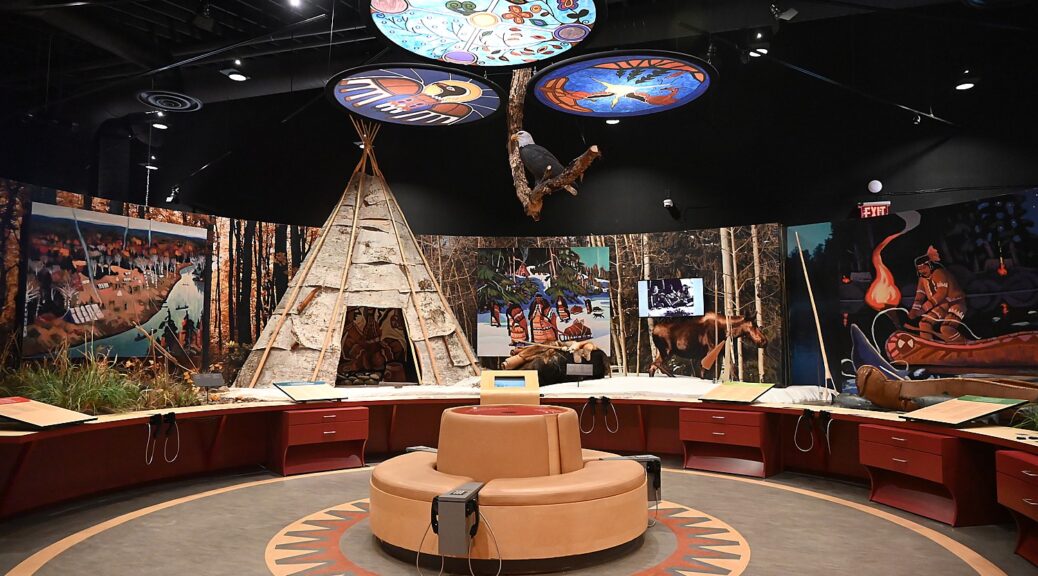By Karen Rubin, Travel Features Syndicate, goingplacesfarandnear.com
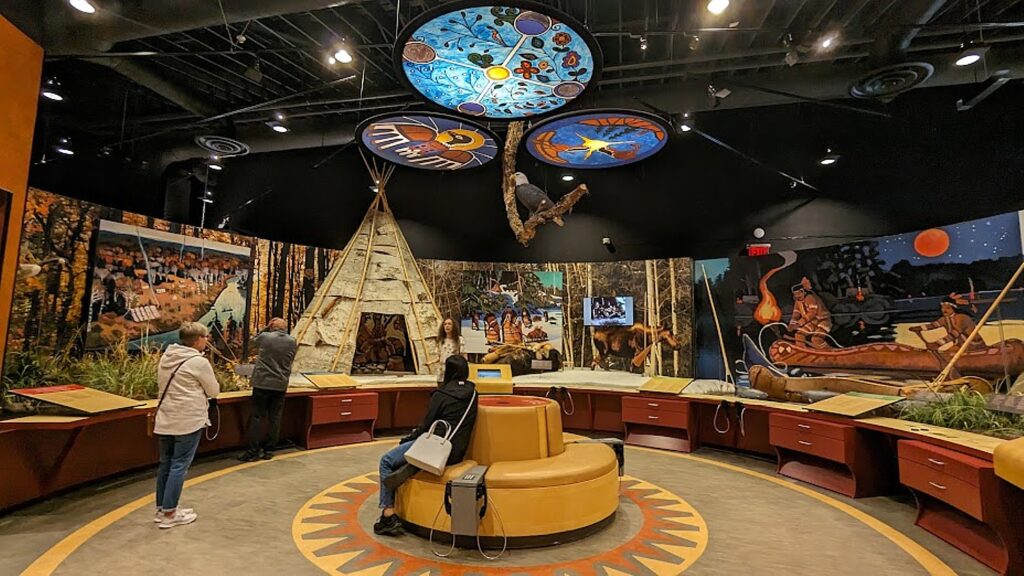
So often the best travel experiences happen by serendipity. I had left the Bay of Fundy coastal trail behind in Moncton this morning to continue our New Brunswick roadtrip, driving 90 minutes to Miramichi, a small city that’s the gateway to northern New Brunswick, Canada, renowned for hunting and fishing. I meet up with Amanda Craig, from Miramichi’s tourism office who was taking me to hike a mile-long trail to Fall Brook Falls (at 108 feet high is the highest in New Brunswick). It’s located in Irving Woodlands private preserve, but alas, the access road is closed. I had spotted a sign along the highway to the Metepenagiag Heritage Park and was really excited to learn more about New Brunswick’s First Nations history and so we head there.
Metepenagiag is so much more than a museum exhibition – it preserves, documents, honors and resurrects the Mi’kmaq heritage and culture.
Metepenagiag is an active archaeological site and research center where artifacts unearthed have provided proof the Mi’kmaq have been occupying this land for at least 3,000 years. When you first walk into the exhibition building, you can look into the lab where researchers examine artifacts. Some of the items, like a 1200-year old Earthenware pot, arrowheads and other items are on display.
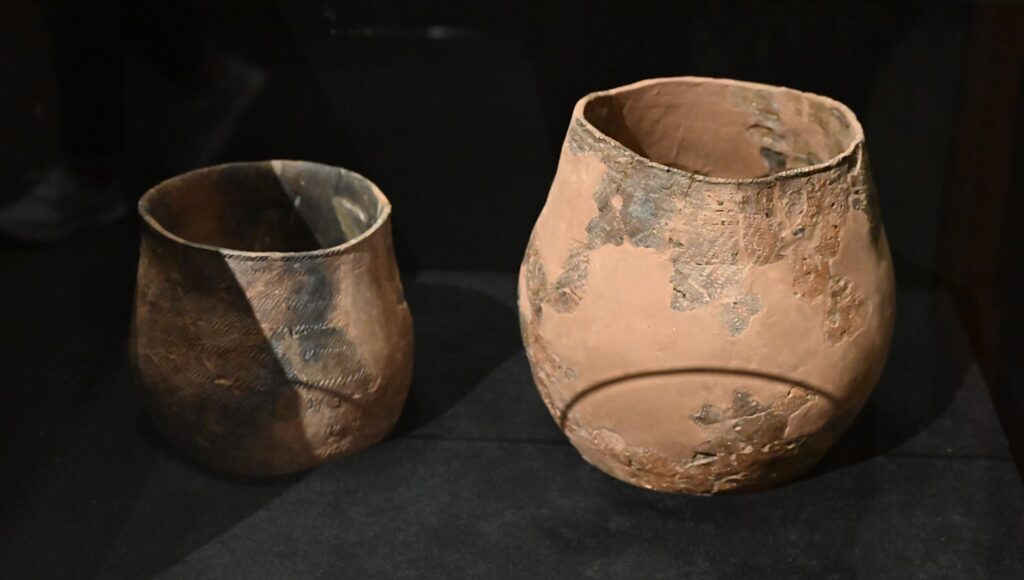
The significance of this place is clear when you learn that it was after decades and generations of a national policy to eradicate First Nations’ cultural heritage, when even speaking the language, so critical to passing along its oral history and tradition, was banned and children were forced from their community into residential schools to strip away their native identity, that in the 1970s, a Mi’kmaq member, Joe Augustine, discovered the Augustine Mound and Oxbow.
“When a company was planning to expand its gravel pit in our community, our beloved and respected Elder Joe Augustine remembered being told from his Elders before him of an old burial ground in the area,” state the notes accompanying a photo of Joe Augustine and Yvonne (Paul) Meunier digging at the pit state. “He went to the site they described and found what was to become the Augustine Mound – a cemetery dating back to over 600 BC.

The concept of preserving, protecting and presenting the rich Mi’kmaq culture is expressed by our Elder and lives on in our community.”
In 1977, archaeological work began on another site Elder Joe Augustine uncovered: the Oxbow, a village site situated at the head tide, showing Metepenagiag has had over 3,000 years of continuous settlements right to the present day.
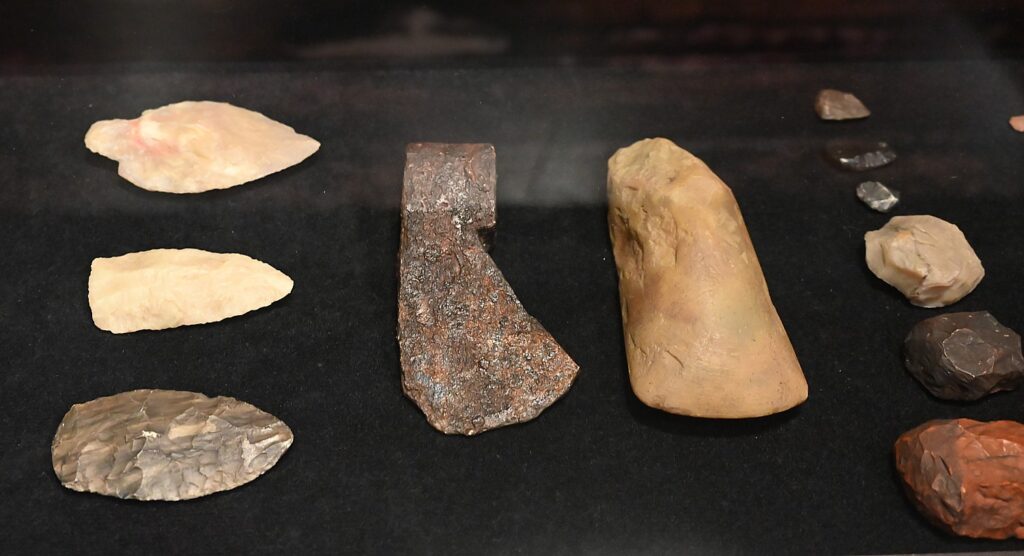
Constructed about 2500 years ago, the circular Augustine Mound is a rare example in the Maratimes of the elaborate burial tradition associated with the Adena culture, which originated in the Ohio River Valley and then spread throughout eastern North America. The rich archaeological record found at the site includes well-preserved textiles and basketry, ornaments of Lake Superior native copper, Ohio fireclay pipes, and distinctive Adena-type stone tools dating back 7000 years.
The types of objects retrieved from the Augustine Mound are exceptional for this area of Canada – copper beads on leather, small pieces of baskets, textiles, animal hides, moose-hair work, porcupine quills, feathers and wooden-handled tools. The salts from thousands of copper beads helped save the raw natural fibers from decomposing.
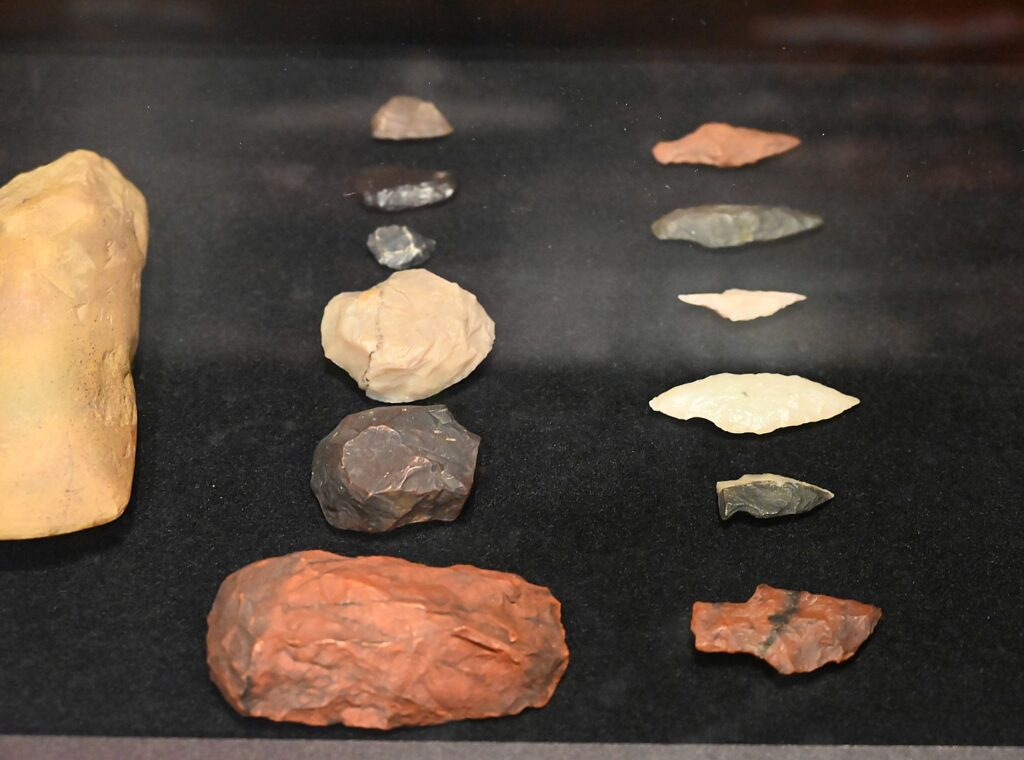
The earth mound, the types of burials and the artifacts suggest that the Mi’kmaq of Metepenagiag probably carried on complex trading and cultural relations with other Aboriginal societies as distant as central Ohio.
Oxbow is one of the largest pre-contact archeological sites in the Maritimes and remarkable for its rich and deeply stratified record of almost continuous human occupation. The artifacts uncovered show that for the past three millennia, aboriginal people have repeatedly come to this oxbow in the Miramichi River to fish, hunt and gather plants. Seasonal flooding covered their camps with silt, preserving evidence of their everyday life, including stone tools, ceramics, and fire pits.
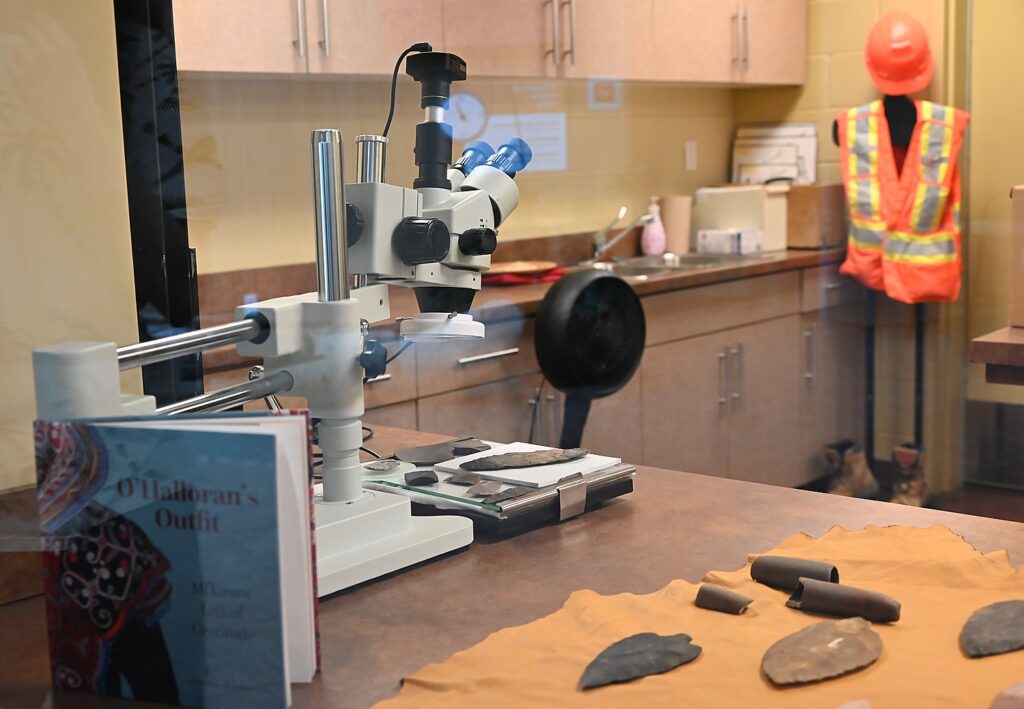
Known today as the Mi’kmaq (from the word nikmaq, meaning my kin-friend), in ancient times they called themselves Lnu’k, The People. The Mi’kmaq are an Eastern Algonkian-speaking people closely related to the Wolastoqiyik, Passamaquoddy, Penobscot and the Eastern and Western Abenaki. Together, these nations formed the Wabanaki Confederacy.
“The findings of these two archeological sites scientifically prove the ancient oral history we have always known, passed down through many generations. This is our legacy and how two national historic sites came to be.”
“Elder Joseph (Joe Mike) Michael Augustine (1911-1995) left an important legacy: the rediscovery of the Mi’kmaq identity and culture as a people and as a nation.” Joe Mike served two terms each as Chief and as a Band Councillor.
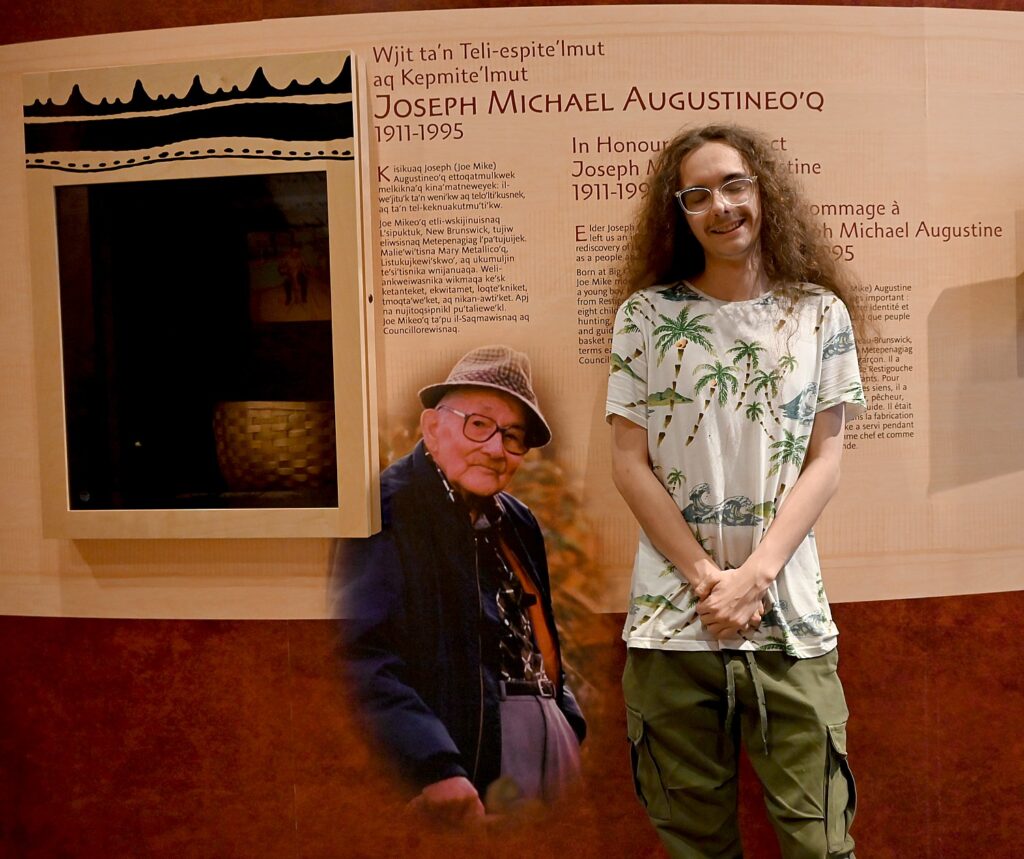
“This is archaeological proof of living here 3000 years,” says our guide, Marcus Alexander LaViolette, heritage interpreter, a 20-something fellow who turns out to be the great grandson of Joe Augustine, making his remarks all the more poignant.
One room displays how the Mi’kmaq would have lived, season by season (they lived along the river in warm seasons, and moved to the forest in cold).
Mi’kmaq ancestors lived in wikuoms (wigwams), not tipis. Some cone- shaped wigwams could hold up to 30 people; A or V-type usually held large groups, which typically would have been built by women.
Marcus shows us a re-created canoe and the skin of an Atlantic sturgeon, which grew to a size “as long as a canoe.” A main food source for generations, the sturgeon, which could grow over 3 meters long and weigh 400 kilos, are now exceptionally rare – the last one was caught 30 years ago. “Sturgeon are an ancient fish in an ancient river; they haven’t evolved,” Marcus tells us.
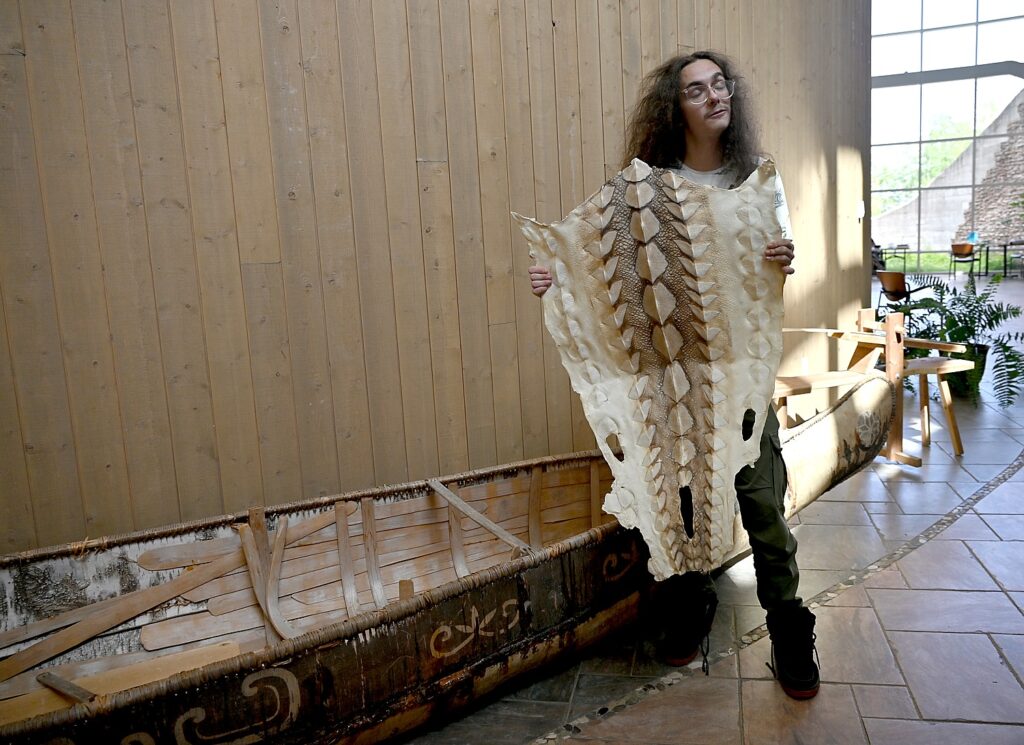
The birchbark canoe “was likely the most remarkable Mi’kmaq construction.” It ranged from 3 to 8 meters long; with high ends and raised sides, a uniquely Mi’kmaq design, that kept the canoe from taking on water. Using this type of canoe, the Mi’kmaq ancestors traveled out to sea, up streams and down rapids. The canoe could transport large loads but was light enough so one or two people could easily carry it.
“We lost the tradition of canoe making,” Marcus tells us, “so this is a generic style for birch bark canoe.”
The exhibit hall is a portal to ancient history, he tells us, stressing that it is a point of pride that all the notes are equally translated in English, French, and Mi’kmaq, especially since only 5% of Mi’kmaq people can understand their native language. There are about 200,000 Mi’kmaq in Canada and in Maine.
Marcus notes that there the pots do not have a flat bottom but would be designed to wedge into the ground. They would boil or cook using superheated sand – which would form a crust around bread and not get into the bread. When it was done, they would pat it like a drum so the sand comes off, leaving the bread. “That they can recreate the process shows proof of concept – shows can do it, re-creatable.” (In the “Taste of Metepenagiag” package, guests learn how to make traditional bread.)
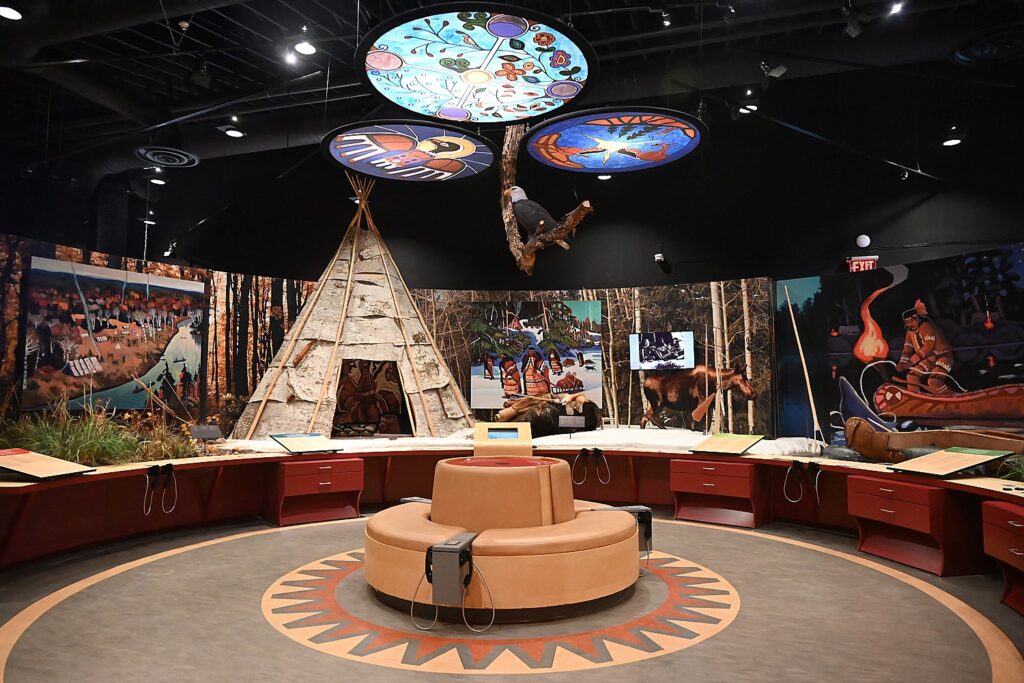
The ancient Oxbow village was next to one of the best salmon fishing pools. For centuries the Miramichi River was a river of fish – so many salmon swam up the river that they would keep villagers awake at night as they fell on the water after leaping into the air. The ancestors smoke-dried a lot of the salmon catch for winter or to use in trade.
The Mi’kmaq ancesters knew the names and uses of trees, plants, flowers and herbs. Foods included fiddleheads, cat-tail roots, raspberries and blueberries. The bloodroot plant provided dye. Balsam fir helped to cure wounds. Canoes and containers were made from birchbark, wood and root, and mats from reeds and rushes. Sweetgrass and tobacco are still used in ceremonies.

“We slowed down First Contact,” Marcus says, then adds, “The Mi’kmaq way of life did not last. With the first Europeans came dramatic changes. The ancestors began to spend more time gathering furs to trade for the prized European goods. They became dependent on Europeans for food. European diseases killed whole Mi’kmaq villages. With few people left to pass on tradition, much knowledge and history was lost.” In fact, the British barred them from hunting or fishing.
This place had always been important for trade – there is even evidence of the Vikings having come. European merchant traders set up a commercial fishery on the Miramichi River in the 1760s that destroyed much of the traditional salmon fishery. “The few Mi’kmaq living at Metepenagiag struggled to survive.”

This is what made a magnificent embroidered, beaded coat that is on exhibit all the more significant, and treasured by the community: it is a re-creation of a fabulous coat, meticulously crafted by local women for a British sea captain, Henry O’Halloran. At a time when the Mi’kmaq were forced onto a reserve and weren’t allowed to hunt or fish, Captain O’Halloran traded with the indigenous people, provided food and formed a close relationship. The coat was made in 1841on the occasion of making him an honorary chief. This one is an exact replica, made by the local women, which if sold, would be valued at $300,000. (Marcus proudly says he got to model it.)
Marcus points to the Treaties of Peace and Friendship, saying, “When our ancestors signed treaties with the British Crown, such as in 1779, they did not give up ownership of our traditional lands. They also kept our rights to fish, hunt, gather and trade.” But these rights were not honored.
In 1994 Metepenagiag signed a historic “loss of land-use” agreement with the government of Canada. But it did not include all of the lands and access to resources that have been taken from our community. Negotiations are continuing in an effort to obtain a fair settlement.” Only recently, each tribal member received $20,000 from the Canadian government as compensation for land.
It is important to note that First Nations people – there are about 2 million in Canada – only received the right to vote without losing their native Indian status in 1960; the last residential school closed as recently as 1995. In 2014, Canada passed the Truth & Reconciliation Act, apologizing for the harm in trying to eradicate indigenous heritage, prompting a policy toward promoting indigenous rights and heritage. Indigenous tourism, a key tool for both economic development and preservation of indigenous heritage and culture, is now Canada’s the fastest growing industry, Amanda says.
At the end of our visit, Marcus says, “First Nations people don’t believe in goodbye – everything is a circle, comes back – even if in next life.”
Metepenagiag Heritage Park has 1800 meters of groomed trails (30 minutes walking time) that let you “walk in the footsteps of our ancestors” to the water.

What is more, you can overnight in a tipi (glamping), cabin or lodge, have a First Nations dining experience, storytelling and be immersed in the 3,000-year heritage around a campfire. Or take part in “A Taste of Metepenagiag” and learn about foods and cooking techniques. New experiences are also being developed.
The Mi’kmaq operate SP First Nations Outdoor Tours, authentic indigenous experiences that begin with a traditional welcome, a river tour by canoe or kayak, storytelling; and authentic First Nations dining and accommodations (56 Shore Road, Red Bank NB, Metepenagiag, 506-626-2718).
Metepenagiag Heritage Park, 2156 Micmac Road, Red Bank NB, 506-836-6118, info@metpark.ca 1-888-380-3555, metpark.ca.
To get to the Metepenagiag Heritage Center, you go through a Mi’kmaq residential community of about 600 people, where you have to be a community member to own the home (but do not own the land). It looks like a typical suburban neighborhood. with its own school (the federal government subsidizes the public school but teachers are paid less than regular school teachers) and shopping center. After the museum was built, the community opened a woman’s shelter, health center. The community also owns Riverside Entertainment (gaming room, restaurant), downtown.
Sportsman’s Paradise
Miramichi is world renowned as a sportsman’s paradise for fishing, hunting, hiking, kayaking, tubing down the rivers, and the longest zipline in New Brunswick (1200 feet). Indeed, the rivers, filled with salmon, and lush wilderness that provided the food and shelter to sustain the Mi’kmaq even 3,000 years ago, continues to sustain Miramichi today.
Miramichi is so prominent for salmon fishing (baseball star Ted Williams used to invite major celebrities including Marilyn Monroe to his family cottage in Blackville), that there is actually an Atlantic Salmon Museum, founded by the local historical society in 1982, that displays 5,000 artifacts “celebrating the artistry of fly tying, the beauty of a well-crafted rod and, above all, the nobility of that ‘king of fish’ the Atlantic salmon.”
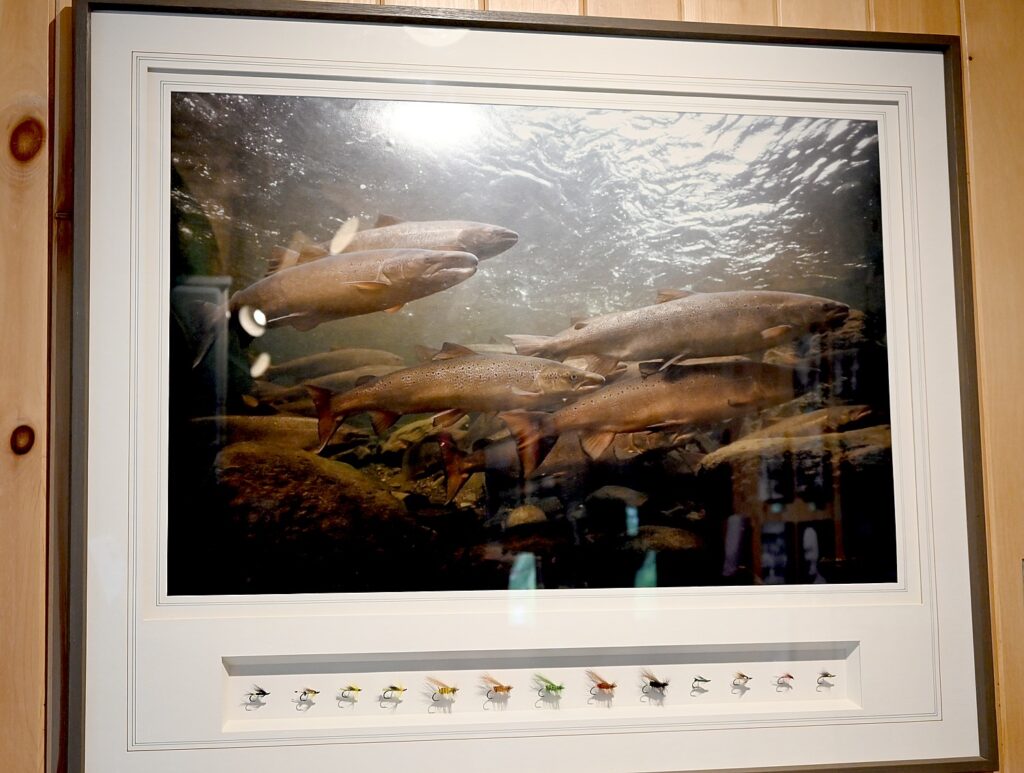
Most notably, the museum is the repository for the internationally revered John William Keith-King collection of 150 plates that feature exquisite flies combined with stunning artwork and historic photos, plus artwork, reels, fishing rods, fishing tackle, fish replicas and antique outboard motors. The collection is valued at $500,000 (the plates alone valued at $5,000 each), Believe me, I never thought such a museum could be so fascinating even to someone who has never fished for salmon. This place is pure bliss for fishing enthusiasts. (Admission is free. Check hours. 263 Main St, Doaktown NB, 506-365-7787, www.atlanticsalmonmuseum.com
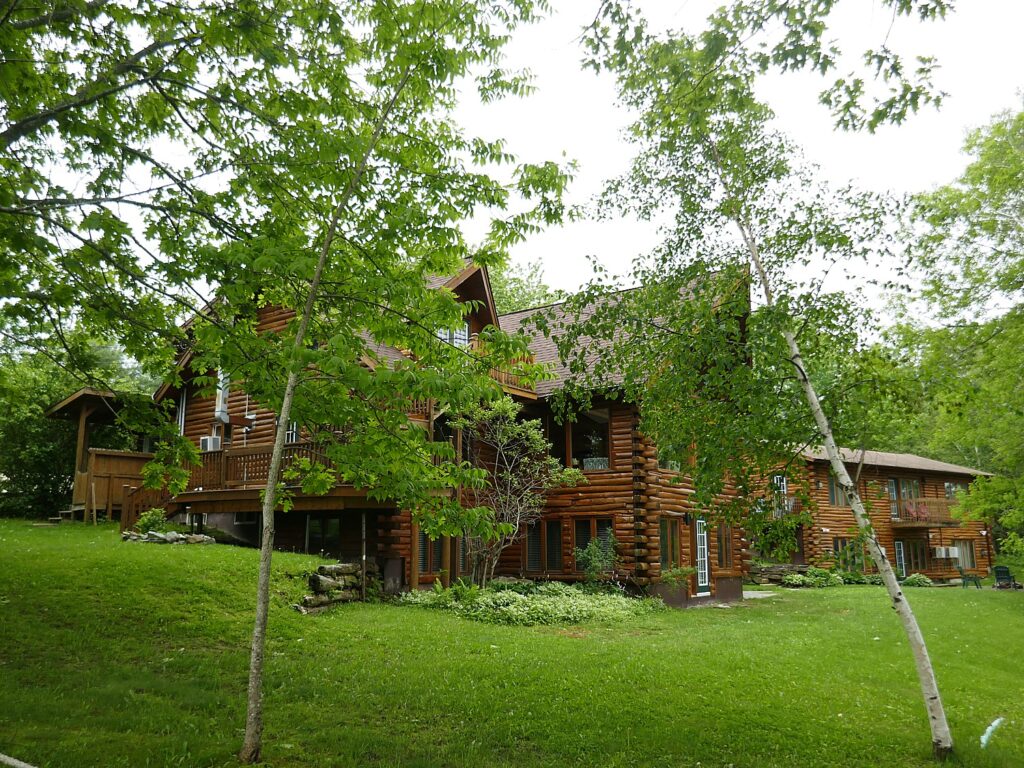
People come from all over for the opportunity to fish and hunt, staying in upscale places like The Ledges Inn, a 4.5-star outfitter with 10-room lodge, picturesquely set on the bank of the Miramichi River, where you can enjoy salmon fishing, upland bird-hunting, four-wheeling, snowmobiling (30 Ledges Inn lane, Doaktown NB, 1-506-365-1820, Ledgesinn.com); and the historic Wilson’s Sporting Camps, family-owned hunting lodge, offering sportsmen retreats since 1855(23 Big Murphy Lane, McNamee NB, 1-877-365-7962, Wilsoncamps.nb.ca).
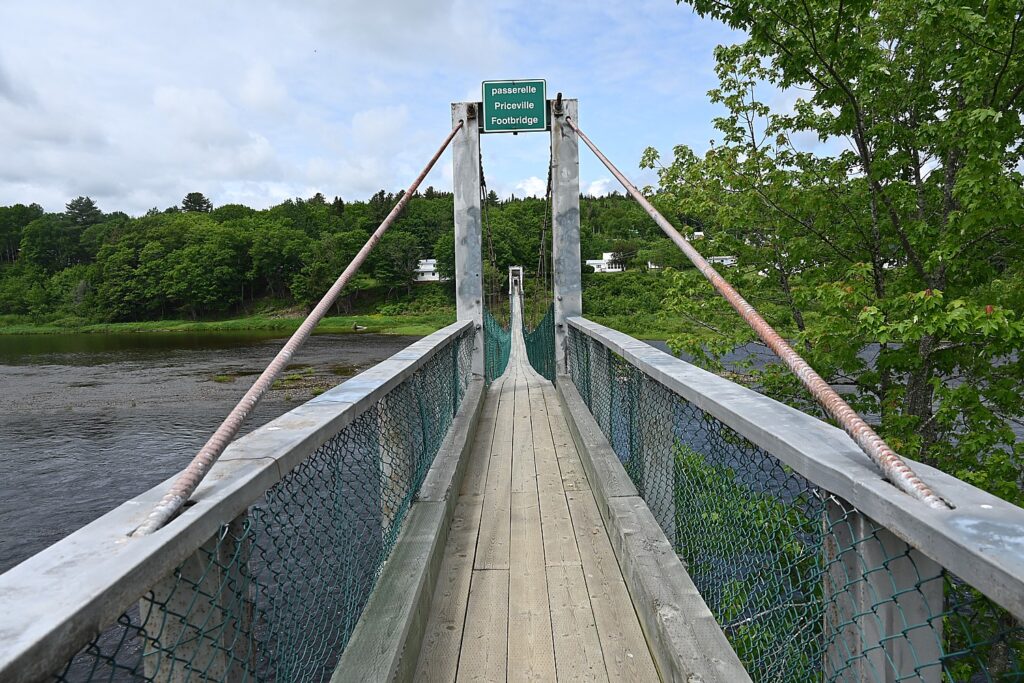
Another local attraction is the Priceville Footbridge, which, local lore has it, was built in 1938 to unite two lovers who lived in villages separated by the river. At 656 feet, it’s the longest suspension bridge in New Brunswick, was damaged and rebuilt in 1939, then replaced in 1988 (McNamee Road. https://tourismnewbrunswick.ca/listing/priceville-suspension-footbridge).
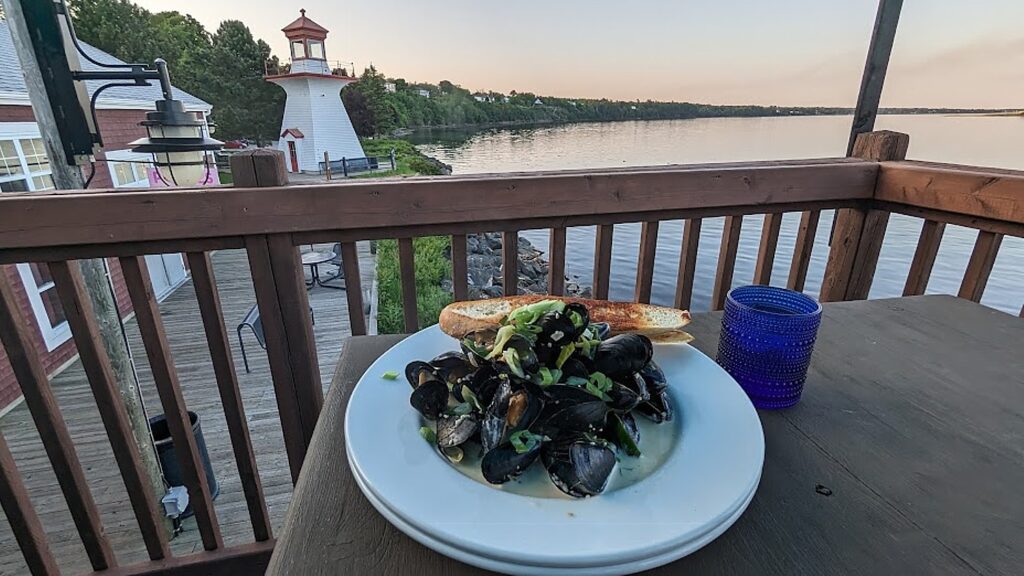
Back in Miramichi, I spend a pleasant evening at Richie Wharf, a charming waterfront park and historic site, where on Friday nights locals come out for music and dancing, After enjoying this scene, I have a delightful dinner (mussels!) at Vera’s patio with a gorgeous view of the sunset on the river. (84 Norton’s Lane, Miramichi, 506-625-2300)
Other Miramichi highlights: There are loads of historic sites we didn’t have time to visit but sound so interesting: Doak House commemorates Scottish entrepreneur Robert Doak who settled here in the early 1820s (386 Main St. Doaktown, 506-365-2026); Wilson’s Point Historic Site, a provincial historic site, contains the Scottish ancestry of Miramichi, but has archaeological significance for the Mi’kmaq people as well as the French Acadians and Loyalists (8 Enclosure Rd., Derby Junction, www.wilsonspoint.com, 506-627-0162); Miramichi History Museum (182 Wellington St., 506-778-4050); Tabusintac Library & Museum (4490 Rte 11, Tabusintac); and W.S. Loggie House & Cultural Centre, a Victorian home with artifacts from 1850 to 2000 (222 Wellington St., Miramichi, 506-775-4996).
Also: Miramichi River Interpretive Trail (1.4 km long, 158 main Street, Blackville; 90-min, Miramichi River Boat Tours out of Richie Wharf; Gallan’s Miramichi River Tubing (Doyles Brook, miramichirivertubing.com); Escuminac Beach (escuminacbeach.com); Historical Beaverbrook House Haunted Tour.
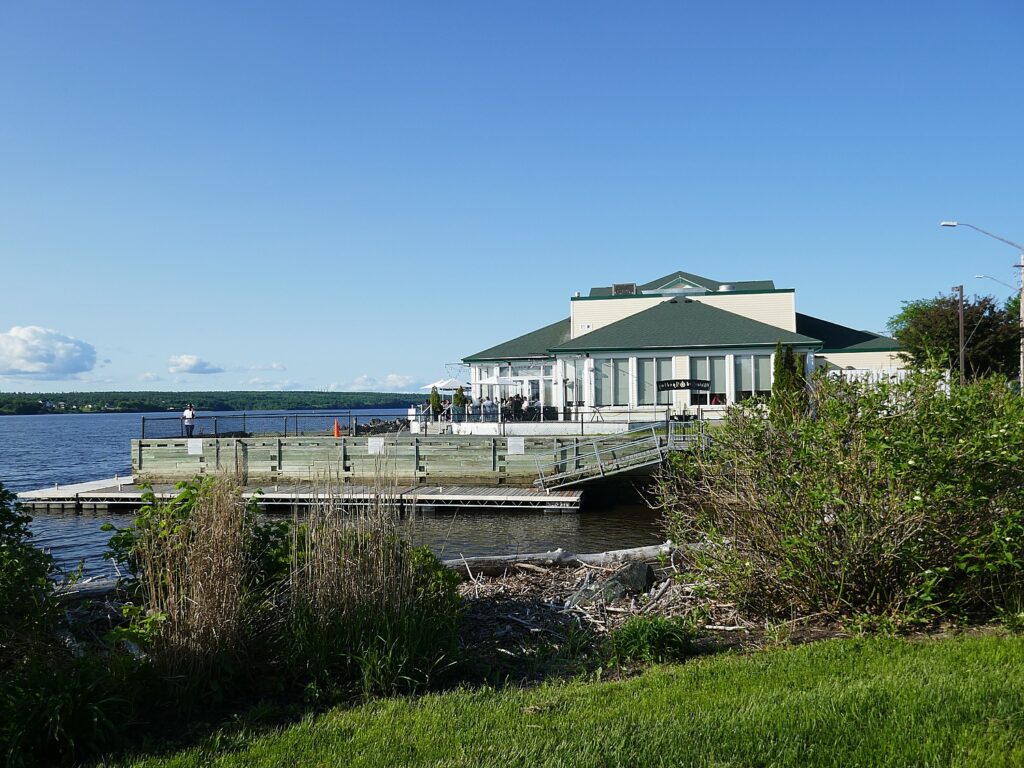
I overnight at the Rodd Miramichi River Hotel, picturesquely set in the waterfront village (1809 Water Street, 506-773-3111).
The next morning, I meet up with David and Laini at the Calico Café; they have been exploring Prince Edward Island and Shediac, where they had a fabulous dinner at Le Mogue Tortue, a restaurant with an Alice-in-Wonderland like setting (tea cups,clocks!), and we continue on our roadtrip to French Acadia, where we will bike on the new Veloroute (bikeway) along the coast, through French fishing villages.
Miramichi Tourism, 800-459-3131, discovermiramichi.com.
Travel planning assistance from Tourism New Brunswick, 800-561-0123, www.tourismnewbrunswick.ca.
See also:
NEW BRUNSWICK ROADTRIP BEGINS IN ST. ANDREWS
NEW BRUNSWICK, CANADA ROADTRIP: SAINT JOHN, CITY OF FIRSTS, OLDESTS, AMAZEMENTS
NEW BRUNSWICK ROADTRIP: DISCOVERING FUNDY TRAIL PARKWAY, FUNDY NATIONAL PARK, CAPE ENRAGE
NEW BRUNSWICK ROADTRIP: MESMERIZING HOPEWELL ROCKS
Next: Exploring French Acadia’s culture and heritage by bike!
____________________________
© 2023 Travel Features Syndicate, a division of Workstyles, Inc. All rights reserved. Visit goingplacesfarandnear.com, www.huffingtonpost.com/author/karen-rubin, and travelwritersmagazine.com/TravelFeaturesSyndicate/. Blogging at goingplacesnearandfar.wordpress.com and moralcompasstravel.info. Visit instagram.com/going_places_far_and_near and instagram.com/bigbackpacktraveler/ Send comments or questions to FamTravLtr@aol.com. Tweet @TravelFeatures. ‘Like’ us at facebook.com/KarenBRubin
